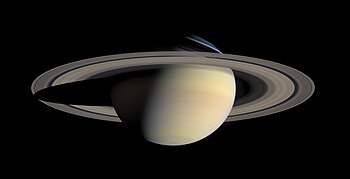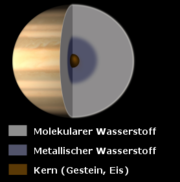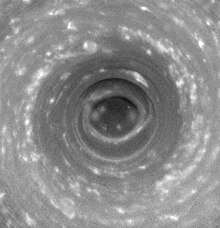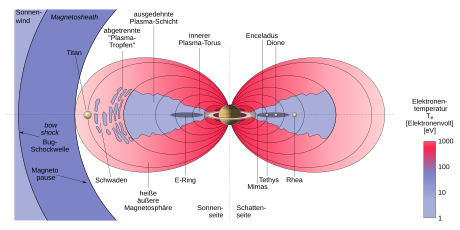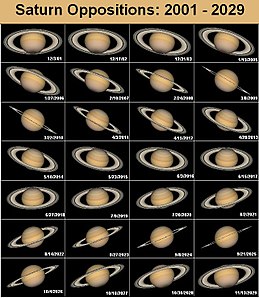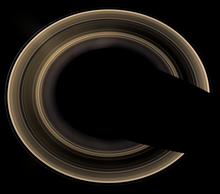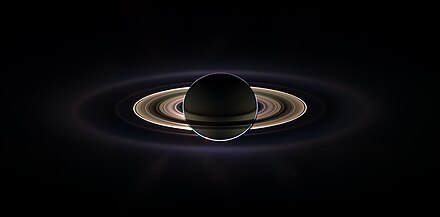Saturn (planet)
| Saturn |
|
|---|---|
| Saturn in natural colors, photographed on October 6, 2004 by the Cassini spacecraft from a distance of 6.3 million km. | |
| Properties of the orbit | |
| Major semi-axis | 9,582 AU (1,433.4 million km) |
| Perihelion - aphelion | 9.041-10.124 AU |
| eccentricity | 0.0542 |
| Inclination of the orbit plane | 2.4845 ° |
| Sidereal period | 29,457 a |
| Synodic period | 378.09 d |
| Mean orbital velocity | 9.68 km / s |
| Smallest - largest distance to earth | 7.991-11.086 AU |
| Physical Properties | |
| Equatorial diameter * | 120,536 km |
| Pole diameter * | 108,728 km |
| Dimensions | ≈95 earth masses 5.683 · 10 26 kg |
| Medium density | 0.687 g / cm 3 |
|
Main components (proportion of fabric in the upper layers) |
|
| Gravitational acceleration * | 10.44 m / s 2 |
| Escape speed | 35.5 km / s |
| Rotation period | 10 h 33 min |
| Inclination of the axis of rotation | 26.73 ° |
| Geometric albedo | 0.499 |
| Max. Apparent brightness | −0.55 m |
|
Temperature * min. - average - max. |
134 K (−139 ° C ) |
| * based on the zero level of the planet | |
| Others | |
| Moons | 82 + ring system |
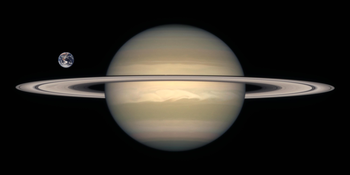
|
|
| Size comparison between Earth (left) and Saturn | |
The Saturn is seen from the Sun, the sixth planet of the solar system and an equatorial diameter of about 120,500 kilometers (9.5-fold the diameter of Earth) by Jupiter 's second largest. At 95 Earth masses , however, it is only 30% of the mass of Jupiter. Because of its conspicuous ring system , which is already visible in a small telescope , it is often called the ring planet , although ring systems have also been found in the other three gas planets .
Saturn has an average distance to the sun of a good 1.43 billion kilometers, its orbit runs between that of Jupiter and that of Uranus , which is further away from the sun . It is the outermost planet that is easily visible to the naked eye and was therefore known for thousands of years before the telescope was invented.
As a gas planet , Saturn has no solid surface. Its upper layers consist of about 96% matter content of hydrogen . Of all the planets in the solar system, Saturn has the lowest mean density (about 0.69 g / cm³). Saturn stands out from the other planets with its distinctive, bright and long-known rings, which largely consist of chunks of water ice and rocks.
The apparent angular diameter of the planet's body is between 15 ″ and 20 ″, depending on the distance from the earth, and that of the rings between 37 ″ and 46 ″. The so-called equatorial stripes of the cloud layers are less pronounced on Saturn than on Jupiter, which is probably related to a high layer of haze .
By 2019, 82 moons of Saturn had been discovered, more than Jupiter's . By far the largest moon of Saturn is Titan with a diameter of 5150 kilometers.
The planet is named after the Roman god of wealth and harvest, Saturn . Its astronomical symbol ♄ stylizes God's sickle.
Orbit and rotation
Orbit
Saturn moves in an approximately circular orbit with an eccentricity of 0.054 around the sun. Its point closest to the Sun, the perihelion , is 9.04 AU and its point furthest from the Sun , the aphelion , is 10.12 AU. Its orbit is slightly inclined towards the ecliptic at 2.48 ° . Further orbital data are the length of the ascending node with 113.72 °, the length of the perihelion with 92.43 ° and the mean anomaly with 49.94 ° for epoch J2000.0 . It takes Saturn about 29 years and 166 days to make one orbit around the sun.
rotation
The equatorial plane of Saturn is inclined 26.73 ° to the plane of the orbit. It does not rotate like a rigid body , but shows a differential rotation as a gas planet : the equatorial regions rotate faster (a rotation in 10 hours, 13 minutes and 59 seconds) than the polar regions (10 hours, 39 minutes and 22 seconds). The equatorial regions are referred to as "System I", the polar regions as "System II". From measurements of the Saturn magnetic field by space probes , an even slower rotation period of 10 hours, 47 minutes and 6 seconds was derived for the interior of Saturn .
In 2007, two US scientists came to the conclusion that the. By means of more recent, combined evaluation of measurement data provided by the space probes Pioneer 11 , Voyager 1 and 2 and Cassini-Huygens on gravity, wind speeds and radio occultations The core of Saturn completed one revolution in 10 hours, 32 minutes and 35 seconds and is therefore seven minutes faster than previously thought. Accordingly, the core should be smaller than expected. With regard to the formation of the gas planet, this could speak in favor of the disk instability hypothesis . According to this hypothesis, Saturn emerged from a collapsing compression of the protoplanetary disk . In the past, the core aggregation hypothesis was mostly adopted as the origin model, according to which Saturn was created from a core of over ten Earth's masses. In the latter model, the core would first have collected from solid components of the gas and dust disk and only then would have sufficiently attracted the gas from its surroundings.
At the beginning of 2019, a further improved measurement of the rotation speed of Saturn was published, which could also be derived from data from the Cassini mission . Then the planet rotates once around its own axis in ten hours, 33 minutes and 38 seconds.
According to a model calculation and observations of crossings of the ring plane, the precession period of Saturn's axis is on the order of two million years.
Physical Properties
Saturn is one of the so-called gas giants . With a diameter of a good 120,000 km, it is the second largest planet in the solar system after Jupiter . Although its volume is 58% of the volume of Jupiter, its mass is less than a third of Jupiter's mass (about 95 Earth's masses ). Saturn therefore has a very low mean density of only 0.687 g / cm³. On average, its material is lighter than water under normal conditions, which is not the case for any other planet in the solar system.
At 1 bar atmospheric pressure (this is generally defined as the “surface” for gas planets), the temperature is 134 K (−139 ° C ) and at 0.1 bar pressure 84 K (−189 ° C).
Upper layers
Its atmosphere , like that of Jupiter, contains mostly hydrogen and helium , but in a different composition. The proportion of hydrogen is significantly higher at around 93% of the mass, the proportion of helium is correspondingly lower at just under 7%. There are also traces of methane , ammonia and other gases.
While the atmosphere of Jupiter contains the elements hydrogen and helium in the same proportion as the sun , the proportion of helium in Saturn is much lower. The rather poorly detailed, yellowish-brown cloud cover contains mostly frozen ammonia crystals .
internal structure
The atmosphere, which like Jupiter mainly consists of hydrogen, gradually changes from a gaseous to a liquid state with increasing depth due to the high pressure. However, there is no defined surface, since the pressure in the depths of the atmosphere increases beyond the critical point and under these conditions a differentiation between gas and liquid is no longer possible. Further down, the hydrogen finally changes into its metallic form. However, in contrast to Jupiter, these layers have different thickness ratios due to their smaller mass. In Saturn, the metallic layer only begins at 0.47 Saturn radii (Jupiter: 0.77 Jupiter radii). Below this layer lies a rock core (more precisely: ice- silicate core), for which model calculations result in a mass of around 16 earth masses . This means that the core of Saturn has a mass fraction of 25%, that of Jupiter only 4%. The inside of the rock core is very hot, the temperature is 12,000 Kelvin . One of the reasons for this is assumed to be the Kelvin-Helmholtz mechanism , a slow compression caused by gravity. As a result, Saturn radiates 2.3 times as much energy as it receives from the sun.
Weather
The clouds that can be seen in the atmosphere of Saturn consist mainly of crystallized ammonia. Saturn has at least two layers of clouds. The upper one covers the lower one, whereby the latter is only visible in the infrared range, since Saturn radiates heat from within. The upper layer of the cloud of Saturn reflects the light of the sun, which makes it easy to observe, and it also has coarser structures than the lower layer.
The North Pole is the center of a polar vortex and a stable structure in the shape of an almost regular hexagon with a diameter of almost 25,000 kilometers. The hexagon, apparently several 100 kilometers deep, was recorded by the Voyager probes in 1980 and 1981; it can also be seen again on the images from 2006 transmitted by the Saturn probe Cassini . The hexagon rotates around itself once every 10 hours, 39 minutes and 24 seconds. This is the same amount of time as the radio emissions from Saturn need for one rotation. The origin of this effect has not yet been clarified.
At the South Pole there is a stationary, hurricane-like storm with a diameter of about 8,000 kilometers.
Other storms have been observed on Saturn, such as the “Great White Spot”, an effect that can be observed every 29 years in the northern hemisphere and is comparable to the “Great Red Spot” on Jupiter.
In 2005, scientists discovered a “hot spot” (a warm place compared to the surroundings) at the south pole of Saturn through observations with the Keck telescope in Hawaii. With this, Saturn differs from all other planets, where the coldest places are in the polar regions. With the help of the orbiter Cassini, astronomers also detected a “hot spot” at the North Pole in January 2008, although it has been dark there for years. These “hot spots” are created by atmospheric gas moving towards the poles. It is compressed and heated up; finally it sinks at the pole in the form of a vortex into the depths of Saturn's atmosphere. Both eddies appear to be long-lived structures whose existence does not depend on solar radiation.
Magnetic field
Saturn has its own magnetic field , the shape of which corresponds to the simple, symmetrical shape of a magnetic dipole . The field strength at the equator is about 20 µT and is therefore about 20 times weaker than the equatorial field of Jupiter (420 µT) and somewhat weaker than the equatorial earth field (30 µT). The magnetic dipole moment , which is a measure of the strength of the magnetic field at a given distance from the center of the planet, is 4.6 · 10 18 T · m 3 580 times stronger than the earth's magnetic field (7.9 · 10 15 T M 3 ). The dipole moment of Jupiter is, however, at 1.55 · 10 20 T · m 3, about 34 times as large, despite the similarly large planetary diameter. Therefore, the magnetosphere of Saturn is significantly smaller than that of Jupiter and only occasionally extends just beyond the orbit of the moon Titan . The almost exactly parallel alignment of the magnetic field axis and the axis of rotation is unique in the solar system . While z. B. With Earth and Jupiter these axes are inclined about 10 ° to each other, with Saturn they are parallel (measurement error at the time (2017) less than 0.06 °.). It is very likely that the magnetic field is generated by a mechanism that corresponds to the dynamo inside Jupiter and is possibly driven by currents in the metallic hydrogen . But there are also competing theories that look for the cause of magnetism in other materials and layers of the gas planet.
As with other planets with a strong magnetic field, Saturn's magnetosphere acts as an efficient protective shield against space weather . Since the solar wind hits the magnetosphere at supersonic speed , a shock wave forms on the side facing the sun , which leads to the formation of a magnetopause . As with Earth and Jupiter, a long magnetic tail forms on the side facing away from the sun.
The great moon Titan , whose orbit is still in the interior of the magnetosphere, contributes to the plasma of the magnetosphere through its ionized upper layers of the atmosphere ( ionosphere ) . The exact structure of the magnetosphere is extremely complex, as both the rings of Saturn and the large inner moons interact with the plasma.
Ring system

Saturn is surrounded by a conspicuous ring system in its equatorial plane , which can be easily seen even in a small telescope . The ring system was discovered in 1610 by Galileo Galilei , who interpreted it as a "handle". Christiaan Huygens correctly described the rings as a ring system 45 years later. Giovanni Domenico Cassini was the first to suspect that the rings consist of small particles and discovered the Cassini division in 1675 .
The rings cast a visible shadow on Saturn - just like, conversely, Saturn on its rings. The shadow cast on Saturn's surface is more pronounced, the more the rather thin main plane of the ring system is inclined in relation to the sun in the course of a Saturn year.
There are more than 100,000 individual rings with different compositions and colors, which are separated from one another by sharply defined gaps. The innermost already begins about 7,000 km above the surface of Saturn and has a diameter of 134,000 km, the outermost has a diameter of 960,000 km. The largest rings are named D, C, B, A, F, G, and E rings in order of their discovery from the inside out.
The gaps between the rings are based on the gravitational interaction with the numerous moons of Saturn and the rings with one another. Resonance phenomena also play a role here, which occur when the cycle times are in the ratio of small whole numbers. Thus the Cassini division is caused by the moon Mimas . Some smaller moons, so-called shepherd or shepherd moons , circle directly in the gaps and at the edges of the ring system and stabilize its structure. New measurements and recordings from the Cassini space probe have shown that the edges of the rings and thus the separation of the rings are even sharper than previously assumed. It was suspected that there were also some chunks of ice in the gaps, but this is not the case.
The ring particles orbit Saturn rechtläufig in the equatorial plane ; thus the ring system, like the equatorial plane, is inclined by 27 ° to the plane of the orbit. Every 14.8 years, the ring system is in the so-called "edge position", in which the thin edge of the rings is exactly facing the earth , so that the ring system is almost invisible. This was last the case in 2009.
With the Spitzer space telescope on October 6th, 2009 a much more distant ring, independent of the main ring system, was discovered on the basis of its infrared radiation, which orbits Saturn in retrograde with the moon Phoebe. Due to its very low matter density, it is not visible visually. The ring is located in a radius of 6 to 12 million kilometers around Saturn and its ring plane is inclined by 27 ° compared to the rings that have been known for some time. It only reveals itself through its thermal radiation with approx. 80 Kelvin. Its material is said to come from the Saturn moon Phoebe. In the meantime (2015) it was found with the space telescope WISE that the ring even extends from 6 million - 16 million km from Saturn. Surprisingly, it consists mainly of very small, dark dust that is extremely thinly distributed.
Another phenomenon are radial , spoke-like structures that extend from the inside outwards over the rings and take on enormous dimensions: at a width of around 100 kilometers, they can be up to 20,000 kilometers long. These “ spokes ” were first discovered by the Voyager 2 probe during its passage in 1981, and later the observation was confirmed by the Hubble space telescope , among others . Oddly enough, these structures gradually disappeared from 1998 onwards and could not be detected again until September 2005 on images taken by the Cassini space probe . A short-lived interaction with the magnetic field of Saturn was initially assumed to be the cause of the banding .
In 2006, however, American astronomers found a different explanation for the mystery of the spoke structures: according to this, the spokes consist of micrometer-sized dust particles charged by the ultraviolet radiation of the sun or the external photo effect , which are lifted out of the rings by electrostatic forces. Depending on the position of Saturn on its orbit , the angle between Saturn's rings and the sun changes and thus also the angle of incidence of the ultraviolet radiation. The dark stripes always appear at periodic intervals when the sun is in the ring plane of Saturn and then exist for about eight years. A streak-free phase, on the other hand, lasts for six to seven years. The reason for the electrostatic charging of the rings continues to be discussed controversially. Another explanation is that lightning bolts occur in the upper atmosphere of Saturn, which generate electron beams that hit the rings.
There are various theories about the origin of Saturn's rings . According to the theory proposed by Édouard Albert Roche as early as the 19th century, the rings were created by a moon that has come so close to Saturn that it broke apart due to tidal forces . The critical distance is called the Roche limit . In this case, the difference in the gravitational forces caused by Saturn on both sides of the moon exceeded the moon's internal gravitational forces , so that the moon would only have been held together by its material structure. After a modification of this theory, the moon was broken by a collision with a comet or asteroid . According to another theory, the rings and Saturn itself were created from the same cloud of material. This theory did not play a major role for a long time, because it was assumed that the rings represent a rather short-lived phenomenon by astronomical standards of a few hundred million years at most. However, this was put into perspective in September 2008. Larry Esposito, the US astronomer who measured the age and weight of Saturn's rings in the early 1980s, corrects his estimates from then. According to new research results, the age of the ring system could be several billion years, which means that there is no longer any question of a short-lived phenomenon. The previous knowledge about the age of the ring system was derived from the amount of starlight that passes through the rings. Esposito and his colleagues have now simulated the behavior of more than 100,000 particles in Saturn's rings. This was possible due to new data from the Cassini space probe, which reached Saturn in 2004. These data were more accurate than those of the probes that visited Saturn in the 1970s and 1980s. The calculations made on the basis of the new measurement data have shown that dynamic processes take place within the rings which make calculating the mass based on the incident starlight much more difficult than previously thought. According to the newly calculated data, the rings could be more than three times as heavy.
Moons
Of the 82 known moons of Saturn today, Titan is the largest with a diameter of 5150 km. The four moons Rhea , Dione , Tethys and Iapetus have diameters between 1050 km and 1530 km. Telesto , Tethys and Calypso move on the same orbit around Saturn with an offset of 60 degrees. A second team of " Trojan moons" are Helene (Saturn XII - S / 1980 S 6) and Polydeuces , who share a path with Dione at an offset of 60 degrees.
Another special feature are the moons Janus and Epimetheus , which orbit Saturn on two almost identical orbits. Every four years they come very close to one another and, due to the mutual attraction, exchange their orbits around Saturn.
In 1905, William Henry Pickering announced that he had discovered another moon. Pickering estimated the diameter to be 61 km. The moon was called Themis , but since it was never seen again, it is considered non-existent.
At the beginning of May 2005 another moon was discovered, provisionally called S / 2005 S 1, which now bears the official name Daphnis . It is the second moon next to Pan , which orbits within the main rings of Saturn.
In June 2006, the telescope on Mauna Kea , Hawaii , discovered nine other moons that orbit Saturn on highly elliptical orbits between 17.5 and 23 million kilometers against its direction of rotation. From this it can be concluded that it must be the captured remains of comets or minor planets. The moon S / 2009 S 1 , discovered by the Cassini Imaging Science Team in 2009, is approximately 300 meters in diameter and is the smallest moon of Saturn that has been discovered to date.
At the time the Cassini space probe entered Saturn's orbit, smaller bodies with a diameter of only about 100 m were found, presumably the remains of a formerly larger body, which form small "lunars" or Saturn's rings. The researchers estimate that there are around 10 million such small structures in the rings of Saturn. They now hope to use these remains to find a clear explanation for the origin of the rings of Saturn.
In 2019, a team led by Scott S. Sheppard from the Carnegie Institution for Science announced the discovery of 20 new moons using the Subaru telescope at the Mauna Kea Observatory in Hawaii. 17 of these moons orbit Saturn against the rotation of the planet, so that the number of retrograde moons, which previously made up the majority, increases to 63. The names of the moons are to be determined from the proposals of a competition running until December 6, 2019 and must come from Scandinavian, Gallic or Inuit mythology.
observation
Like all upper planets , Saturn is best observed in the weeks around its opposition , when it is closest to Earth, facing the Sun and culminating at midnight. In the years 2016–2018 this is the case in June - cf. the list of Saturn positions .
The size of its “disk”, which is clearly visible in the telescope from 20x magnification, only fluctuates by ± 10 percent over the year, not by almost 20 percent as with Jupiter. The ring of Saturn and the largest moon Titan can be seen in binoculars , the equatorial stripes from around 40x magnification, and all the next smaller 4–5 moons in an eight-inch (standard telescope with 20 cm lens).
One month after the opposition, Saturn already culminates at around 10 p.m. (or 11 p.m. CEST) and can then be seen in the southwestern evening sky as a star of the first magnitude , until it is visible to the naked eye in the light of the setting sun after another 3-4 months disappears.
In contrast to the four planets closer to the Sun, daytime observations of Saturn in the telescope are hardly possible, as it only just stands out from the blue of the sky. If this is still possible, the ring can also be seen during the day at low magnification.
exploration

Before the space age
Saturn has been known since ancient times. In ancient times it was the most distant of the five known planets in the starry sky.
In 1610 the Italian mathematician, physicist and astronomer Galileo Galilei sent Johannes Kepler the anagram Smaismrmilmepoetaleumibunenvgttavrias in order to secure the priority of a discovery without having to divulge it. When Galileo was certain of his observations, he also revealed the solution. It is:
- Altissimum planetam tergeminum observavi -
- I saw the uppermost planet in three forms .
Shortly before, Galileo had observed Saturn for the first time through one of the first telescopes and believed he could see rounded bulges on both sides of the Saturn disk. In 1612, however, Galileo could only see the Saturn disk itself, believed he had been mistaken in his earlier observations and did not pursue the strange matter any further. Since the ring was in the edge position in that year, it was in fact not recognizable for the telescopes of that time.
Other astronomers such as Fontana , Gassendi , Hevelius , Riccioli or Grimaldi were also only able to determine the presence of the appendages in the following decades, without being able to explain their appearance and their occasional disappearance. Only after Christiaan Huygens discovered a moon ( Titan ) on March 25, 1655 thanks to improved self-made telescopes and followed it for several months, did the systematic observation of the planet associated with it lead him to the conviction, published in 1659, that Saturn was surrounded by a free-floating ring, and that its shape, which is always perceived differently, is explained by the different inclinations with which it presents itself to the viewer during a Saturn orbit. Huygens determined the inclination of the ring to the ecliptic to be 31 ° and the node length to be 169½ °.
Giovanni Domenico Cassini discovered the Saturn moon Iapetus in 1671 , Rhea in 1672 , Dione and Tethys in 1684 . In 1675 Cassini also described the division in the rings of Saturn named after him .
The noticeable flattening of Saturn had already been measured by Grimaldi as 1/12, but it was not until 1790 that William Herschel succeeded in determining the duration of rotation; he received 10 h 16 m , which was in good agreement with the flattening.
Herschel had also discovered the two moons Mimas and Enceladus in 1789 . The eighth moon, Hyperion , was found by Bond and Lassell around the same time in 1848 .
The moons and the perturbations exerted by Saturn on the other planets made it possible to determine the mass of Saturn. Newton found 1/3021 solar masses (1726, from the orbital period of Titan), Bouvard 1/3512 (1821, from the faults), Leverrier 1/3530 (1876, from the faults), Hall 1/3500 (1889, orbital time of Titan ).
In 1850, Bond and Lassell proved the inner, translucent crepe ring, which earlier observers had occasionally described. The four outer fog rings seen by D. Lamey from 1868 could not be confirmed.
William Henry Pickering discovered the far out circling moon Phoebe in 1898 .
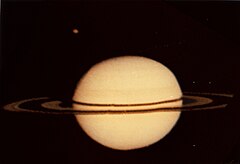
Pioneer 11
On September 1, 1979 , Pioneer 11 was the first probe ever to pass Saturn at a distance of 21,000 km. The probe flew between the A-ring and the F-ring, which was only discovered by the probe. 17 hours before the flyby, the moon Epimetheus was discovered, which the probe passed at a distance of 2500 km. 220 pictures of Saturn and one of Titan were taken, but they showed no details below a resolution of 500 km. The black gaps in the rings were found to be bright when observed toward the sun. This means that these columns are not devoid of matter. They also studied Saturn's magnetic field, which was previously unknown. Further results were that Saturn emits energy, the hydrogen content of Saturn is greater than that of Jupiter and that Titan has a dense cloud cover.
Voyager 1
On November 12, 1980, the Voyager 1 space probe visited Saturn. It provided the first high-resolution images of the planet, rings and satellites. For the first time, surface details of various moons became visible. In addition, several moons were newly discovered. The flyby of Titan had initially gone exceptionally bad, as the thick layer of smog over Titan did not allow any recordings. The cameras were then reprogrammed and the atmosphere of Titan analyzed. It was found that this consists of nitrogen, methane, ethylene and cyanohydrocarbons. The data rate at which the probe could transmit images was 44,800 bit / s . As a result, the Voyager probe had to start taking images early in order to get enough data. The fly-by maneuver changed the direction of the spacecraft and it left the plane of the solar system.
Voyager 2
Almost a year after Voyager 1, on August 25, 1981, the sister probe Voyager 2 arrived at the ring planet. One got even more high-resolution pictures of the moons of Saturn. By comparison with the Voyager-1 images, changes in the atmosphere and the Saturn rings were found. However, as the camera's pivoting platform got stuck for a few days, some scheduled pictures could not be taken. Temperature and pressure measurements were taken of the atmosphere. The probe confirmed a few moons and found several new moons near or within the rings. The small Maxwell gap in the C-ring and the 42 km wide Keeler gap in the A-ring were discovered. Saturn's gravity was used to direct the probe towards Uranus.
Cassini-Huygens
After a seven-year flight, the Cassini-Huygens space probe passed Saturn's moon Phoebe on June 11, 2004 at a distance of only 2068 km and examined it up close.
On July 1, 2004, the probe went into orbit around Saturn. At the beginning of 2005, scientists used Cassini to observe thunderstorms on Saturn, the flashes of which probably released around 1000 times more energy than that of Earth. This storm was described as the strongest ever observed in 2007.
On September 20, 2006, a previously unknown planetary ring was discovered based on an image taken by Cassini, which is located outside the lighter main rings, but inside the G and E rings. The material of this ring probably comes from collisions of meteorites with two moons of Saturn.
In October 2006, the probe detected a hurricane with a diameter of 8,000 km, the eye of which is on the south pole of Saturn.
The orbiter “Cassini” also carried the landing probe “Huygens” with it, which landed on January 14, 2005 on the moon Titan and took pictures of methane lakes on the lunar surface. Due to an operator error on Cassini, who served as a relay station for communication with the earth, only every second image of the probe was transmitted back to earth. On October 26, 2004, Cassini also took radar photos of the surface of Titan from an altitude of 1200 km.
On March 10, 2006, NASA reported that Cassini had found underground water reservoirs just below the surface of the moon Enceladus .
The probe also discovered four other moons of Saturn.
On September 15, 2017, after the fuel was used up, the probe was deliberately allowed to burn up in the Saturn atmosphere in order to exclude the possibility that the no longer controllable probe would collide with a Saturn moon and biologically contaminate it. Up until the day before, she had been conducting research and sending imagery to Earth.
Cultural history

Since Saturn is clearly visible to the naked eye and is noticeable as a wandering star , it was given mythological interpretations in ancient times. In ancient Egypt he symbolized the deity Horus as Hor-ka-pet ("heavenly bull") . The Sumerians called it Lubat-saguš ("star of the sun"), while the Babylonians called Saturn, referring to its orbital speed, Kajamanu ("the constant"). In ancient Greece it was considered to be the planet of the god Kronos , so the Romans gave it the name of the corresponding god Saturnus . In Hindu astrology , Navagraha refers to Saturn as Shani .
In medieval astrology, Saturn, traditionally represented with a sickle or scythe, was among others. a. for unhappiness - worry, melancholy, illness and hard work - but also for order and measure. Following on from this, Saturn has remained a symbol of melancholy in the fine arts (including Albrecht Dürer : Melencolia I ) and in literature (including Georg Trakl : Trübsinn) .
In Chinese and Japanese cultures, Saturn stands for the earth. This is based on the five elements teaching . The Ottoman and Indonesian languages call Saturn, derived from the Arabic زحل, as Zuhal . In Hebrew, Saturn is called Shabbathai .
Konradin Ferrari d'Occhieppo suspected in 1965 that the star of Bethlehem was a very rare and close triple Saturn-Jupiter conjunction in the zodiac sign Pisces . In fact, the two gas giants met three times during the year 7 BC, on May 27th, October 6th and December 1st. This year seems to fit in well with the approximate time of Jesus' birth. Babylonian astronomers may have interpreted the meeting of the planets Saturn and Jupiter as an important clue.
The English day name Saturday still clearly refers to the planet Saturn, which as one of the seven walking stars of the geocentric view of the world under the seven days of the week in Babylon was the original namesake of Saturday .
See also
literature
- Thorsten Dambeck: Saturn's moon in tatters: The rings of Saturn could be the debris of a shattered moon . Bild der Wissenschaft , 9/2006, pp. 60-63, ISSN 0006-2375
- Ronald Weinberger: Precise determination of the rotation of Saturn . Naturwissenschaftliche Rundschau 59 (12), pp. 664-665 (2006), ISSN 0028-1050
- Reinhard Oberschelp : Giuseppe Campani and the ring of the planet Saturn. A document in the Gottfried Wilhelm Leibniz Library . Reading room series, 35th CW Niemeyer, Hameln 2011, ISBN 3-8271-8835-0 (including an illustration from 1666)
Web links
- RPIF Inventory: Saturn
- The planet Saturn: interesting facts and Flash film
- Solar System Exploration: Saturn. In: NASA.gov. (English).
- NASA page about Saturn (English)
- List of Saturn's moons (English)
- High-resolution image with a semi-professional amateur telescope (English)
- A View of Earth from Saturn NASA Earth Observatory, Image of the Day, January 16, 2007
- Northern lights are unique. On: Wissenschaft.de of February 19, 2005. About an article in Nature (Volume 433, 2005, p. 717, p. 720 and p. 722).
media
- Why does Saturn have rings? from the alpha-Centauri television series(approx. 15 minutes). First broadcast on July 30, 2000.
Individual evidence
- ↑ a b c d David R. Williams: Saturn Fact Sheet. In: NASA.gov. October 15, 2019, accessed on May 15, 2020 .
- ↑ Ravit Helled, Eli Galanti, Yohai Kaspi: Saturn's fast spin determined from its gravitational field and oblateness . In: Nature . tape 520 , no. 7546 , 2015, p. 202-204 , doi : 10.1038 / nature14278 .
- ↑ John D. Anderson, Gerald Schubert: Saturn's Gravitational Field, Internal Rotation, and Interior Structure. In: Science. Sept. 7, 2007, Volume 317, No. 5843, pp. 1384-1387, doi: 10.1126 / science.1144835 .
- ↑ Astronomie-heute.de: The core of Saturn rotates faster than expected . On: astronomie-heute.de of September 10, 2007.
- ↑ Christopher Mankovich, Mark S. Marley, Jonathan J. Fortney and Naor Movshovitz: Cassini Ring Seismology as a Probe of Saturn's Interior. I. Rigid rotation . The Astrophysical Journal, Volume 871, Number 1
- ↑ Spiegel Online from January 19, 2019: Astronomers finally know what time it is on Saturn
- ^ WR Ward, DP Hamilton: Tilting Saturn. I. Analytic Model . In: The Astronomical Journal . tape 128 , 2004, pp. 2501–2509 , doi : 10.1086 / 424533 , bibcode : 2004AJ .... 128.2501W .
- ^ Courtin, R .; Gautier, D .; Marten, A .; Bezard, B .: The Composition of Saturn's Atmosphere at Temperate Northern Latitudes from Voyager IRIS spectra . In: Bulletin of the American Astronomical Society . 15, 1983, p. 831. bibcode : 1983BAAS ... 15..831C .
- ↑ a b The Solar System - Saturn ( Memento from October 6, 2011 on WebCite ) National Maritime Museum, 2011
- ↑ NASA Saturn World Book. Retrieved September 7, 2019 .
- ^ Radiation on Saturn
- ↑ Saturn as "Martinslaterne" ( Memento from August 20, 2008 in the Internet Archive ) In: gerhards.net, October 5, 2006
- ↑ Cassini Images Bizarre Hexagon on Saturn, Jet Propulsion Laboratory Press Release 2007-034, March 27, 2007 . A more recent picture of the hexagon can be found on the NASA homepage.
- ↑ Page no longer available , search in web archives: Great White Spot In: spacetelescope.org
- ↑ Astronews surprise at the north pole of the ring planet
- ^ A b C. T. Russell, JG Luhmann : Saturn: Magnetic Field and Magnetosphere . UCLA - IGPP Space Physics Center , 1997, accessed September 13, 2007 .
- ^ CT Russell, JG Luhmann : Jupiter: Magnetic Field and Magnetosphere . UCLA - IGPP Space Physics Center , 1997, accessed September 13, 2007 .
- ^ A b Matthew McDermott : Saturn: Atmosphere and Magnetosphere . Thinkquest Internet Challenge , 2000, accessed July 15, 2007 .
- ↑ Russian Telegraph Saturn's inexplicable 'lack of tilt' leaves scientists with magnetic field conundrum
- ↑ NASA Special Publication Passage to a Ringed World : Chapter 6 - A Sphere of Influence ( Memento of March 3, 2008 in the Internet Archive ) (PDF; 256 kB)
- ↑ Historical Background of Saturn's Rings. Retrieved September 7, 2019 .
- ↑ The King of Rings. NASA, October 7, 2009, accessed October 7, 2009 .
- ↑ spiegel.de
- ↑ Saturn's giant ring is even bigger , in scinexx.de, accessed: June 15, 2016 , the article states as the source: Douglas P. Hamilton, Michael F. Skrutskie, Anne J. Verbiscer, Frank J. Masci: Small particles dominate Saturn's Phoebe ring to surprisingly large distances. In: Nature. 522, 185–187 (June 11, 2015)
- ↑ Wissenschaft.de: Striped like lightning. Retrieved September 7, 2019 . About the enigmatic spokes in the ring system
- ^ CJ Mitchell et al .: Saturn's Spokes: Lost and Found . Science , March 17, 2006, Vol. 311. No. 5767, pp. 1587-1589
- ↑ Cassini discovers spokes
- ↑ Lightning is supposed to disturb Saturn's rings
- ^ Saturn's known satellites ( memento from January 19, 2008 in the Internet Archive )
- ↑ Current Cassini images of the moons
- ↑ NASA - WaveMaker Moon
- ↑ "Saturn in Mondbad" in: Frankfurter Allgemeine Sonntagszeitung of 13 October 2019
- ↑ Lars Fischer: New record: Saturn has the most moons in the solar system. Retrieved October 8, 2019 .
- ↑ a b c d R. Wolf: Handbook of astronomy, its history and literature . Schulthess, Zurich 1892, reprint Olms 1973, par. 553.
- ↑ a b c d R. Wolf: Handbook of astronomy, its history and literature . Schulthess, Zurich 1892, reprint Olms 1973, par. 554.
- ↑ a b c d e R. Wolf: Handbook of astronomy, its history and literature . Schulthess, Zurich 1892, reprint Olms 1973, par. 555.
- ^ K. Schaifers, HH Voigt (ed.): Landolt-Börnstein . Gruppe VI, Vol. 2a, Springer, Berlin 1981, p. 137.
- ^ K. Schaifers, HH Voigt (ed.): Landolt-Börnstein . Gruppe VI, Vol. 2a, Springer, Berlin 1981, p. 139.
- ^ Pioneer Mission Description ( Memento from January 30, 2006 in the Internet Archive )
- ↑ Pioneer 10 + 11
- ↑ a b Voyager probes
- ↑ Missions to Saturn
- ↑ Astronomers Find Giant Lightning Storm At Saturn. ScienceDaily LLC, 2007, accessed July 27, 2007 .
- ^ David Shiga: Faint new ring discovered around Saturn. NewScientist.com, September 20, 2007, accessed September 7, 2019 .
- ^ Paul Rincon: Huge 'hurricane' rages on Saturn. BBC, November 10, 2006, accessed June 12, 2007 .
- ↑ Probe reveals seas on Saturn moon
- ^ Cassini Discovers Potential Liquid Water on Enceladus. Retrieved September 7, 2019 .
- ↑ Article on space.com , accessed September 15, 2017
